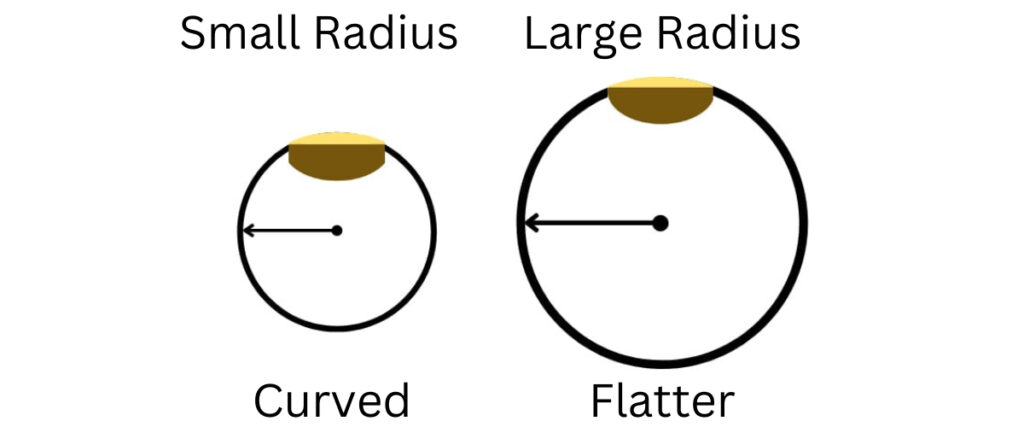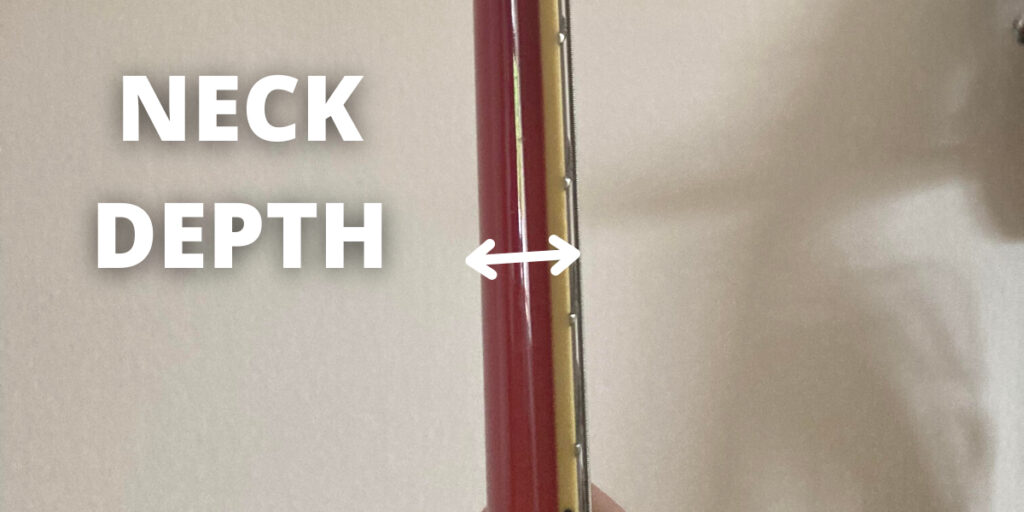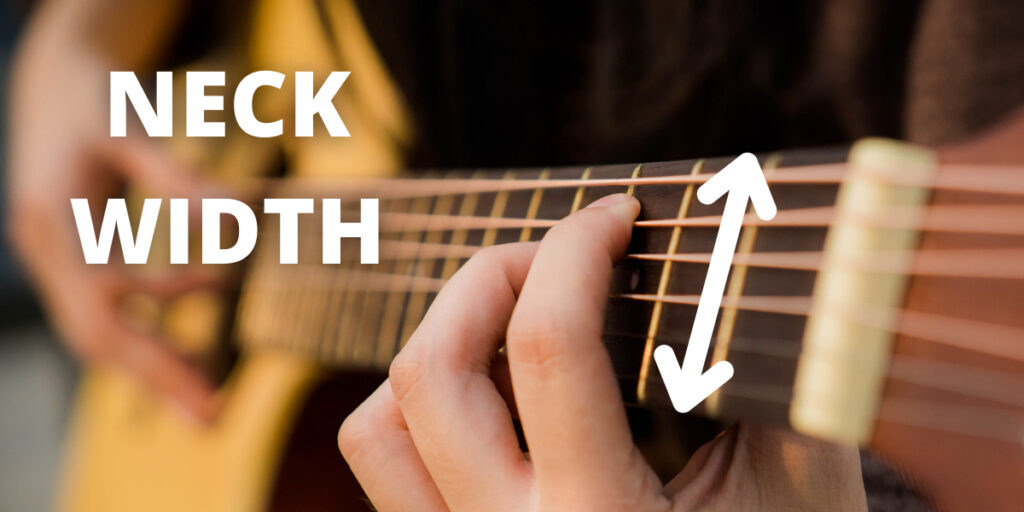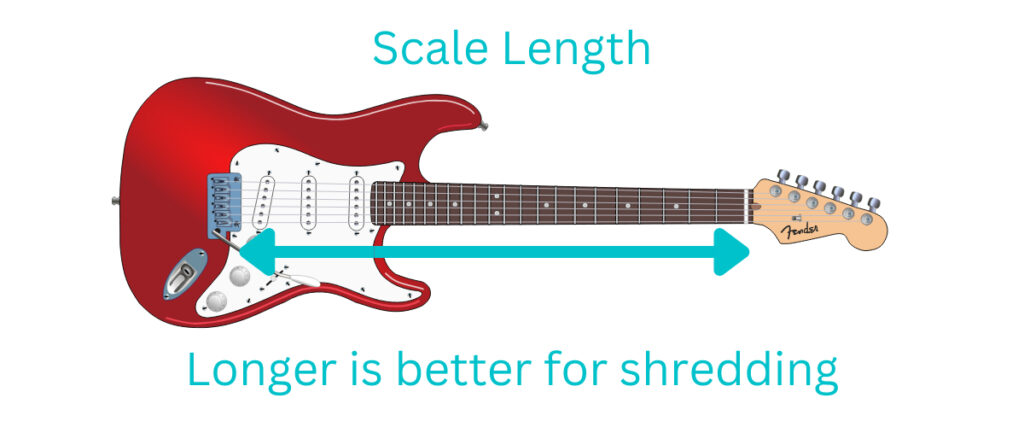If you’re in the market for a new electric guitar and shredding is your primary focus, then you’ll need to carefully consider the neck shape and size as this massively affects how easy it is to shred.
In this article I’ll take you through the most important characteristics of a shredding neck, and a list of the best necks for shredding by the most popular electric guitar brands.
Characteristics of a Shredding Neck
Neck shape and dimensions are all personal preference, however many “shredder’s necks” have the following characteristics:
- Profile: D-shape, C-shape or U-shape
- Fingerboard Radius: 12″ or above
- Thin and wide dimensions
- Longer scale length (above 25.5″)
- 24 frets
- Satin finish
Neck Profile
The C-shape neck is widely regarded as being the most universally comfortable neck shape and it’s good for a range of styles. However, the D-shape neck is arguably more suitable for shredding.

D-shape necks have broader shoulders compared to C-shape necks which have more curved shoulders.
This means that the back of a D-shape neck is a bit flatter which is great for shredding as it is perfect for anchoring the thumb. With a C-shape neck, the thumb will be anchored on more of a curve which doesn’t feel quite as stable.
Check out this article comparing C-shape and D-shape necks to learn more.
U-shape necks are seen on some shred-style guitars, but they’re quite a polarising shape. They feel fuller in the hand compared to C-shape and D-shape necks and are only really favoured by players with longer fingers.
Many U-shape necks are described as “baseball necks” such as those found on ’50s style Telecasters, and these are very unsuitable for shredding. However, it is possible to get thin U-shape necks which are a good option for shredding if you prefer the feel of this profile over the D and C-shape.
V-shape necks are generally avoided for shredding because they have very shallow shoulders and a pointed shape. Soft-V shape necks are better than hard V-shape necks because they aren’t quite as pointed, but they’re not all that popular.
Fingerboard Radius
All fingerboards are slightly curved. The fingerboard radius refers to the degree of curvature.
- Larger fingerboard radius = flatter feeling
- Smaller fingerboard radius = curved feeling
Check out this diagram to demonstrate.


A larger radius, and hence flatter feeling fingerboard is better for shredding. Conversely, a smaller radius, and more curved feeling fingerboard is better for holding chords.
Many shred-style guitars have a fingerboard radius of 15″ or above. You don’t have to go that high if you find chords more uncomfortable with a very flat radius, however I’d personally steer clear of anything lower than 12″ if shredding is a big focus for the guitar.
Some guitars have a “compound radius” which changes as you go up the neck. The most common compound radius is 12″-16″ where it’s more curved at the lower frets and flatter at the upper frets which gives you the best of both worlds for shredding and chords.
Another huge benefit of a larger radius (flatter fingerboard) is that it allows you to have a lower action without causing fret buzz. A low action (string height) is very important for shredding as it makes it easier to play more quickly.
Depth and Width
- The depth of the neck refers to how thick the back of the neck is. This is often incorrectly referred o as the width. A neck with a shallower depth is preferable for shredding.
- The width of the neck refers to how wide the fretboard is. The most common metric to use here is the nut width. A wider neck (larger nut width) is recommended for shredding.


Let’s address the depth first.
Having a neck with a shallow depth (aka a thin neck) is ideal for shredding as it allows the guitarist to move their hand more quickly and adopt a more classical hand-position with the thumb on the back of the neck. This is why many guitars which are marketed towards shredders have very thin necks.
However, you have to be careful not to go too thin, as it can cause the hand to cramp up a bit. The exact measurement will vary from person to person based on their hand size and ideal positioning.
Check out this list of electric guitars with the thinnest necks.
Now let’s consider the width.
Having a wider neck is better for shredding as it means there’s more space between each of the strings. Again, there’s no one-size-fits-all measurement (as is the case for all the specifications), however most shred-style necks have a nut width of roughly 42 mm or more.
The width of the neck will increase as you get further from the nut though, so some guitars may have a narrower width at the nut and then a much wider width around the 12″ fret where it’s more important for shredding. For example, the Ibanez RG530 has a nut width of 43 mm and 24th fret width of 58 mm.
Scale Length and Frets
The scale length of a guitar is the distance between the guitar’s nut and the bridge. I’d advise going with a longer scale length if you are using the guitar for shredding. By this I mean anything over 25.5″ is a good place to be.
Longer scales put the strings under more tension which means two things:
- It’s possible to get a lower action without getting fret buzz
- Longer scale lengths are better if you want to use lighter strings (which are easier to fret)
I’d also recommend going with a 24 fret instead of a 22 fret guitar for shredding as this will give you more notes to play with. In terms of the fret size, many shredders also prefer jumbo or medium jumbo frets.
Check out my complete guide to fret sizes e.g. jumbo, medium jumbo, vintage, narrow tall etc.

Neck and Fretboard Finish
Finally, an important characteristic of a shredding neck is a satin finish. Satin finishes feel smooth and non-tacky which makes it a lot easier to quickly move up and down the fretboard. Gloss finishes should be avoided as these can feel very sticky and slow you down.
If you find the perfect neck but it has a gloss finish, you can just sand it down to achieve a satin finish. It won’t look as fresh if you do an amateur job, but it should still feel nice and smooth.
Best Shredding Necks
As I have already mentioned, neck shape and size is personal preference. All shredders don’t play the exact same neck. Some prefer a C-shape, others prefer a D-shape or U-shape. Some like a 12″ fingerboard radius, and others play best on a 16″ radius.
I’d always encourage that you go to your local guitar store and try a range of neck shapes and sizes. This way you’ll be able to figure out exactly what characteristics work best for your hand size and positioning.
With that said, there are some neck designs that lend themselves very well for shredding and are good options to look at if you’re struggling to narrow down the selection.
Here are some of the most popular electric guitar necks for shredding:
- Ibanez Super Wizard
- Schecter Ultra Thin-U
- Schecter Ultra Thin-C
- Jackson Speed Neck
- ESP Thin-U
- Fender American Ultra
Ibanez Super Wizard
There are many different types of the iconic Ibanez Wizard neck and they’ve earned their name as some of the best necks for shredding due to their super thin dimensions. The Super Wizard is seen on some of the Prestige line-up including the RG-series models and is the thinnest version available.
This neck is super flat with a whopping 17″ radius making it ideal for shredding, however it’s worth noting that it’s not very versatile due to the incredibly flat design so you may want to go with something a bit more curved if you need the guitar for chording as well.
Some players also don’t like this super thin design, it’s all personal preference. The other Wizard neck versions are a bit thicker (but still very thin) so they are usually a bit more universally comfortable.
- D-Shape
- 17″ radius
- 0.67″ thick at the 1st fret
- 0.75″ thick at the 12th fret
- 1.69″ (43 mm) nut width
- 24 frets
Check out my guide to the different types of Ibanez wizard neck profiles.
Schecter Ultra Thin-U
Schecter’s Ultra Thin-U neck can be found on models such as the Banshee. It’s very thin but not as thin as the Ibanez Wizard necks, so is a bit more universally comfortable. The large compound radius gives it a nice flat feel which is ideal for shredding.
- U-Shape
- 12″-16″ compound radius
- 0.75″ thick at the first fret
- 0.79″ thick at the 12th fret
- 1.65″ (42 mm) nut width
- 24 frets
Schecter Ultra Thin-C
Another great shredder’s neck is the Schecter Ultra Thin-C. It’s found on guitars such as the Reaper has the same dimensions as the thin-U, it’s just the profile that differs between the two. The thin-C has shallower shoulders compared to the thin-U which feels fuller due to those more broad shoulders.
- C-Shape
- 12″-16″ compound radius
- 0.75″ thick at the 1st fret
- 0.79″ thick at the 12th fret
- 1.65″ (42 mm) nut width
- 24 frets
If you’re looking for a thicker C-shape then go for the Thin-C Schecter neck which can be found on the Hellraiser model. This is still relatively thin, and has similar width and thickness specifications to the Jackson Speed Neck and ESP Thin-U, it just differs in terms of the profile mainly.
Jackson Speed Neck
The Jackson Speed Neck is seen on many of their electric guitars including the soloist. It has a compound radius and is relatively thin. It has that classic D-shape profile which feels nice and flat on the back and perfect for anchoring the thumb for shredding.
- D-Shape
- 12″-16″ compound radius
- 0.79″ thick at the 1st fret
- 0.85″ thick at the 12th fret
- 1.69″ (43 mm) nut width
- 24 frets
ESP Thin-U
The ESP Thin-U style neck is seen on many ESP/ LTD 6-string models such as the E-II. It’s not super aggressive and actually pretty versatile for chording as well as shredding so it’s a good option if you don’t like the feel of super flat and wide necks.
- U-Shape
- 12″ radius
- 0.79″ thick at the 1st fret
- 0.87″ thick at the 12th fret
- 1.65″ (42 mm) nut width
- 24 frets
Fender American Ultra
If you want to go with a Fender guitar for shredding then the American Ultra series models are the best. These necks don’t have quite as “aggressive” specs compared to some of the ones listed above, so they’re a good option if the guitar isn’t solely for shredding and you want something a bit more versatile for rhythm.
- Modern D-shape
- 10″-14″ compound radius
- 0.82″ thick at the 1st fret
- 0.87″ thick at the 12th fret
- 1.685″ (42.8 mm) nut width
- 22 frets
Comparison Table
*If you’re on mobile/ small-screen device then either turn your phone horizontally or scroll to the side to see the full table
| Specification | Ibanez Super Wizard | Schecter Ultra Thin-U | Schecter Ultra Thin-C | Jackson Speed Neck | ESP Thin-U | Fender American Ultra |
| Profile | C | U | C | D | U | D |
| Radius | 17” | 12-16” | 12-16” | 12-16” | 12” | 10-14” |
| 1st Fret Thickness | 0.67” | 0.75” | 0.75” | 0.79” | 0.79” | 0.82” |
| 12th Fret Thickness | 0.75” | 0.79” | 0.79” | 0.85” | 0.87” | 0.87” |
| Nut Width | 1.69” | 1.65” | 1.65” | 1.69” | 1.65” | 1.69” |
| Frets | 24 | 24 | 24 | 24 | 24 | 22 |
Check out my ultimate guide to neck shapes for everything else you need to know.
